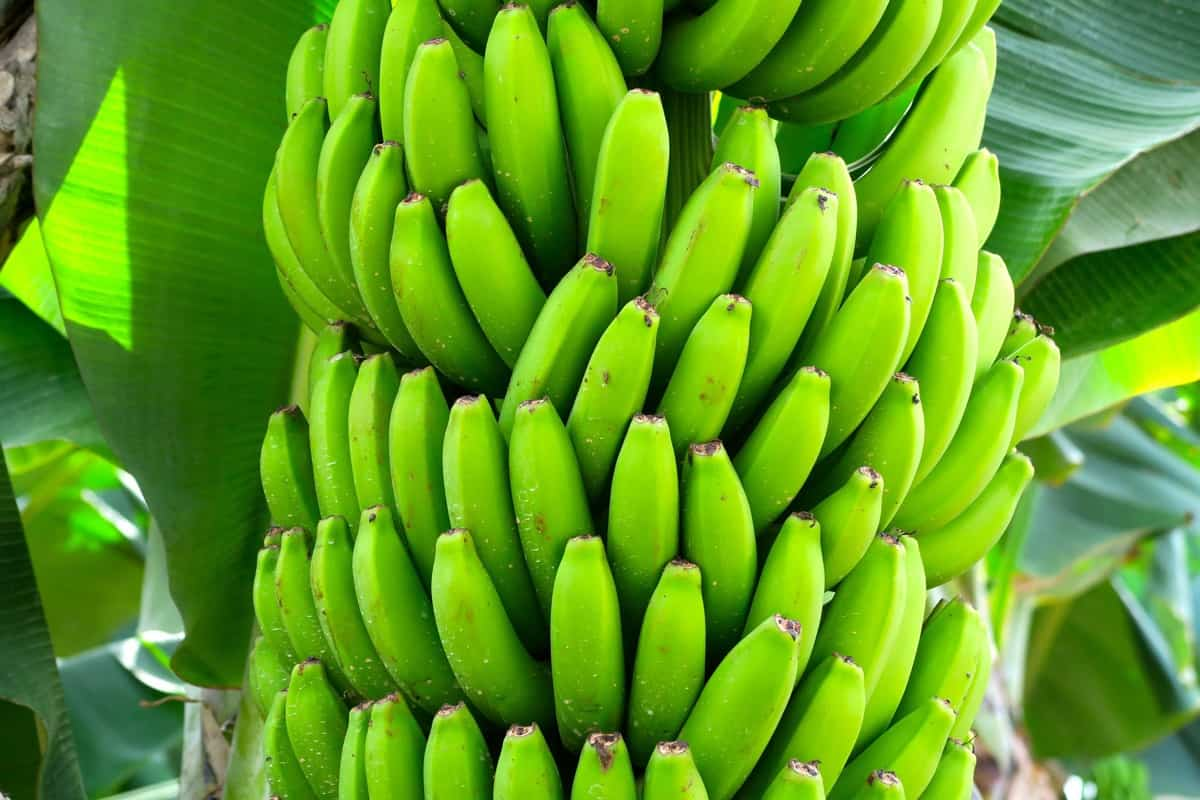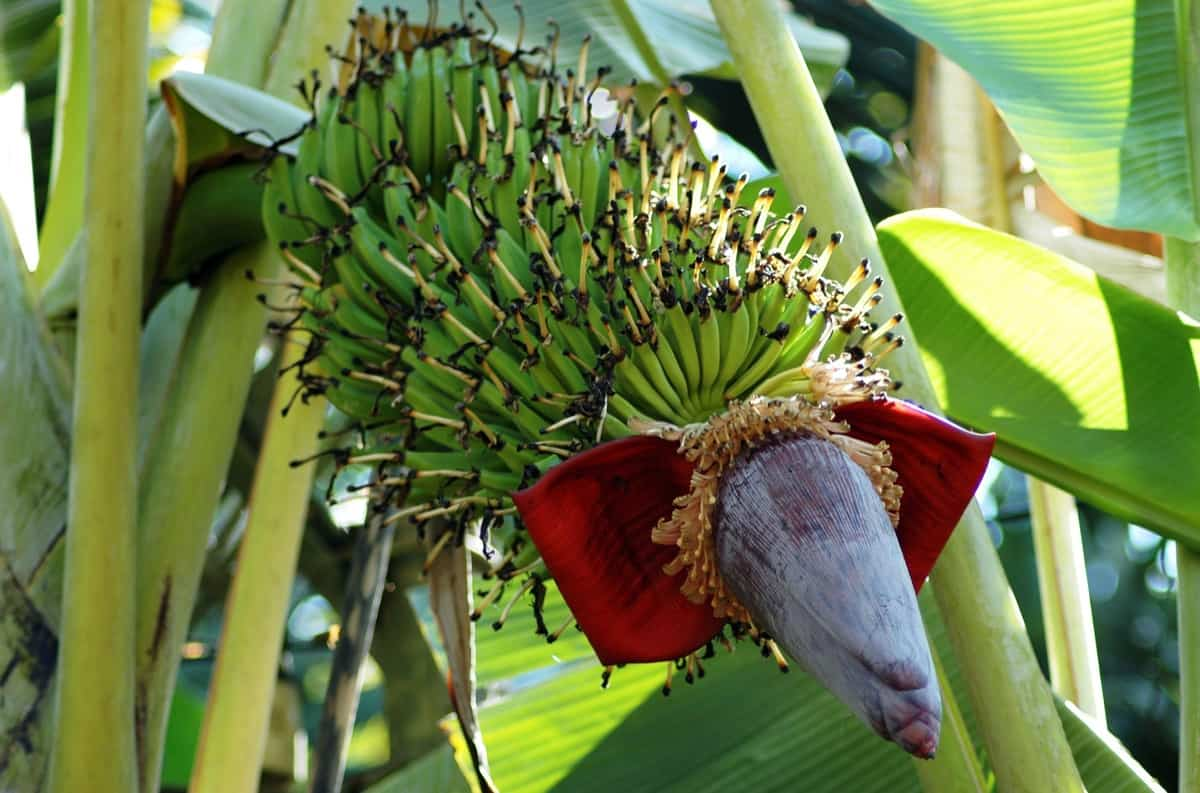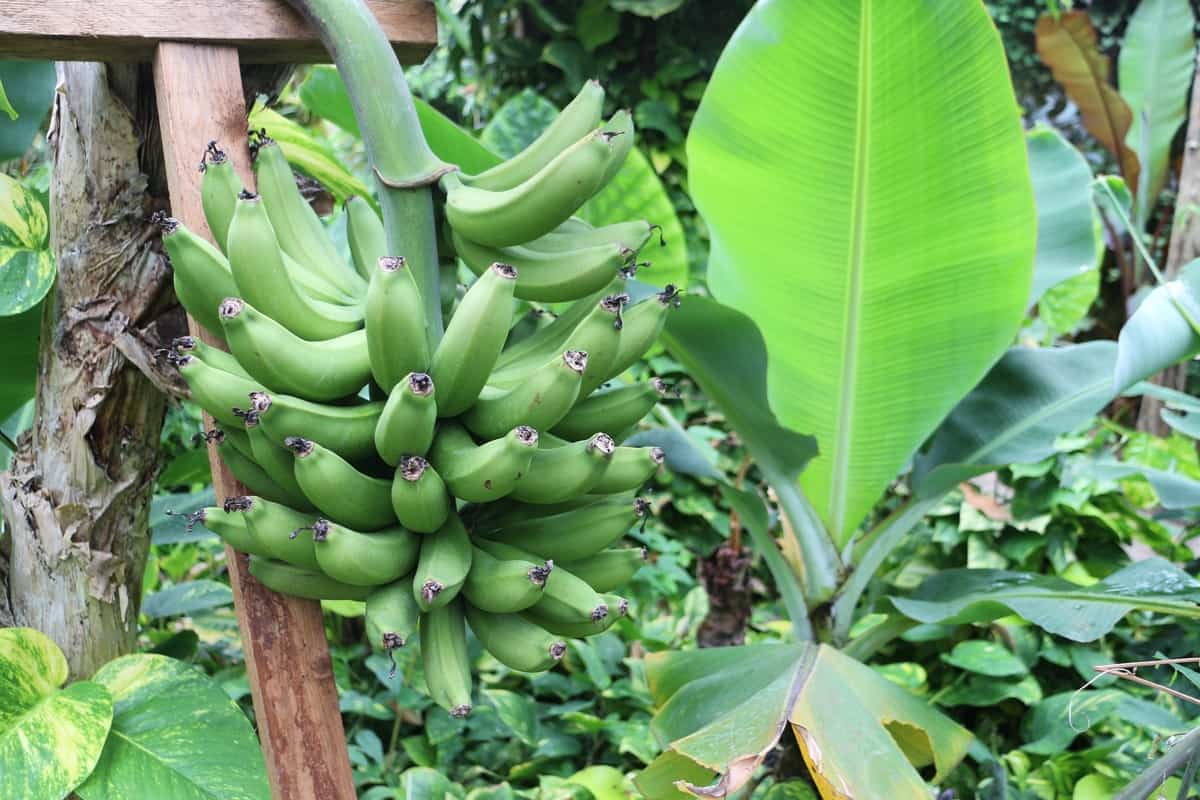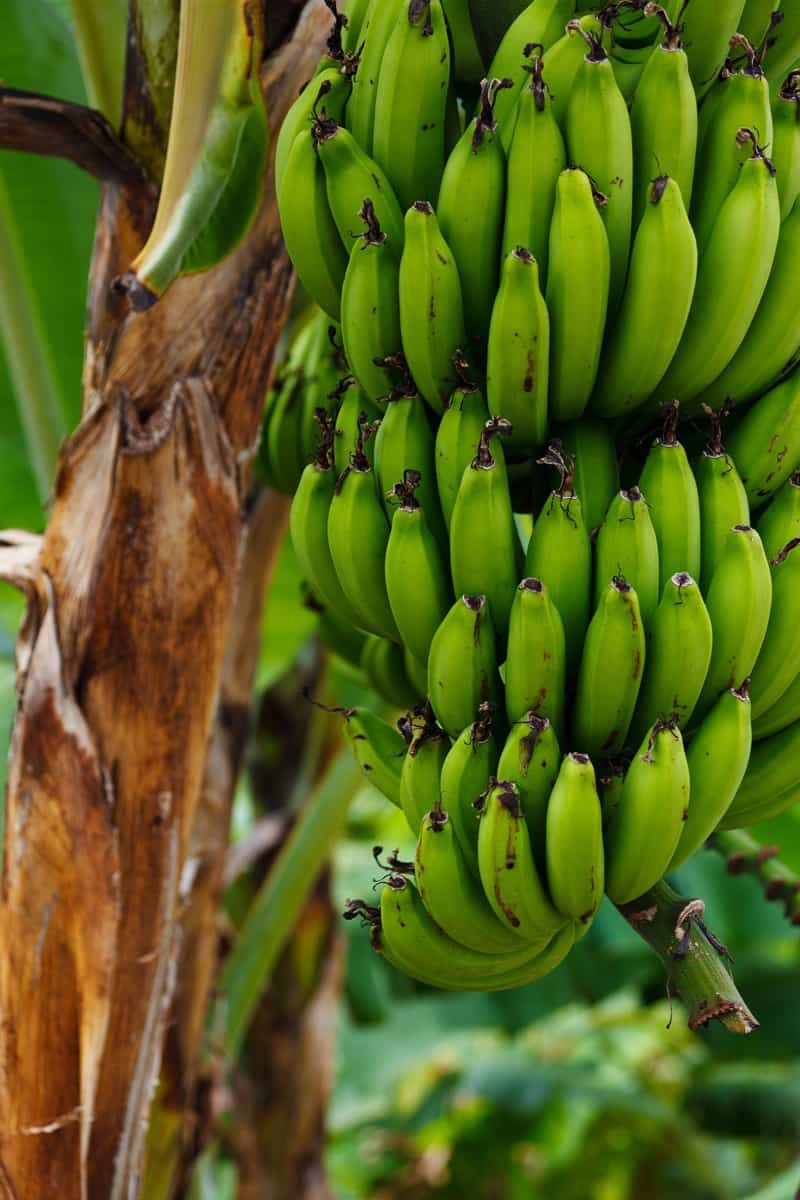The banana plant is the world’s largest herbaceous perennial plant and a member of the Musaceae family. Bananas are grown for their fleshy, curved fruit. There is a sturdy pseudostem (not a stem, as it is made from rolled leaf bases), and the leaves are arranged spirally at the top of the plant.

Among fruit crops, bananas rank first in production and third in the area in India. Fruit production accounts for 33% of the area and 13% of the total production. Maharashtra has the highest production, followed by Tamil Nadu. A national average of 12 tons per acre is achieved by Maharashtra, which produces 26 tons per acre. Kerala, Karnataka, Gujarat, Andhra Pradesh, and Assam are major banana-producing states.
Nendran banana production in India
Nendran banana
Nendran, the commercial plantain variety in Kerala, occupies 50 % of the total area in the state & maximum quantity of the fruit is sold locally. Small quantity is exported to the middle east, with a target of a large Indian community. Also, separate AEZ in Kerala for bananas has boosted the export of plantain. Presently shipment carried out by air is constrained by the higher expenses involved. This protocol of sea shipment is prepared with national & international references, where practical trials have been conducted for the shipment’s quality.
It is used for both table and processing purposes. In recent years, commercial cultivation of Nendran has exploded in Tamil Nadu. Nendran is known to display considerable diversity in plant stature, pseudostem color, presence or absence of male axis, bunch size, etc. The bunch has 5-6 hands weighing about 12-15 kg. Fruits have a distinct neck with thick green skin turning buff yellow on ripening. Fruits remain as starchy even on ripening. Nendran is susceptible to Banana Bract Mosaic Virus (BBMV), nematodes, and borers.
Special features
- It is one of the important varieties for the processing industry.
- They are largely grown in Trichirapalli and Coimbatore districts.
- Fruits are eaten ripe and raw or used as a vegetable in the mature unripe condition.
- Fruits remain as starchy even on ripening.
- The plant has distinct pink coloration in pseudostem.
- Bunch not compact, 12-15 kgs, 4-6 hands, three prominent ridges, distinct nipple.
- Fruits – large, long, thick, peel – thick and leathery, golden yellow, peels with difficulty.
- Pulp – firm, flesh-colored, core fairly conspicuous mild flavor, medium sweet.
- It has good keeping quality and is not suitable for ratoon crop.
- Crop duration 11-12 months.
- Culinary Nendran is a dual-purpose variety used for dessert and culinary.
- Nendran Varieties: Nedunendran, Chengalikodan, and Attunendran & Nendran are grown throughout Kerala. The prominent districts are Thrissur, Ernakulam, Malappuram, Calicut, Palghat, and Wynads.
In case you missed it: Robusta Banana Farming in India: Cultivation Practices and Production Management

Soil requirements for Nendran banana
Bananas are heavy feeders, so soil fertility is important for successful cultivation. Bananas have a restricted root zone, making them one of the rare fruits that do. Thus, depth and drainage are two of the most important factors when choosing banana soil. For bananas to thrive, the soil should be rich, well-drained, fertile, moisture-retentive, and contain plenty of organic matter.
A pH range of 6.5-7.5 is ideal for banana cultivation. It is best to cultivate bananas on alluvial or volcanic soils. In India, bananas are grown on various soil types, including heavy clay soil of the Cauvery delta, alluvial soils of the Gangetic delta, black loam in Maharashtra, coastal sand loams, and red lateritic soil in the hilly tracts of Kerala. Bananas are famous for growing in these areas.
Climate & temperature for Nendran banana cultivation
Tropical and subtropical climates are suitable for banana farming. Cultivating bananas is possible in regions with a relative humidity of 70 to 75% and a temperature range of 15 to 35 degrees Celsius. Chilling injury occurs when the temperature is below 12 degrees Celsius, and wind speeds above 85 kilometers per hour can also damage the crop. It is essential for robust plant growth during monsoons to receive an average rainfall of 650 to 750 mm per month. There are banana plants that can be grown from sea level up to 2000 meters above mean sea level.
Selection of Nendran banana suckers
- Choose ‘Sword Suckers’ with broad corms and narrow sword-like leaves from disease-free mother plants.
- Nendran, Rasthali, Ney Poovan, and Poovan Banana varieties require suckers to be 3-5 months old, uniform and weighing 1-1.5 kg.
- The suckers should be slightly bigger than 1.5-2.0 kg for long-duration varieties like Karpuravalli and Red Banana.
- For ‘Tissue Culture’ plantings, the secondary hardened plant should be around 30 cm tall, have a 5 cm circumference, and have five fully opened healthy leaves.
Selection and pre-treatment of suckers
Trim the roots and decayed portions of the corm, cutting the pseudostem 20 cm away from the corm, and grading the suckers. Infected portions of the corm may be pared and dipped in 0.1% Emisan solution (1 g in 1 lit of water) for 5 minutes. Carbofuran 3 G granules are used for a preliminary per sucker in 40 grams. Next, the corm should be dipped in a slurry solution consisting of four parts clay plus five parts water and sprinkled with carbofuran to control nematodes.
The corm can also be dipped in 0.75% Monocrotophos, dried in the shade for at least 24 hours, and planted. Sunhemp should be sown 45 days after germination and incorporated about a month later. Nematode buildup is reduced by this operation. The banana plants should have five or six leaves when tissue-cultured. For each plant, apply 25 grams of Pseudomonas fluorescence.
Land preparation
Growing green manuring crops like daincha, cowpea, etc., is recommended before planting a banana. Plowing and leveling the land can be done 4-6 times. Before the last harrowing, the basal dose of FYM (about 50 tonnes/ha.) is added and thoroughly mixed into the soil. A blade harrow or laser leveler is then used to level the field. In most cases, a pit size of 45cm x 45cm x 45cm is required.
In case you missed it: Yelakki Banana Farming in India: Production and Cultivation Management Practices

A mixture of topsoil, 10% FYM (well decomposed), 250 grams of Neem cake, and 20 grams of carbofuran will be added to the pits for refilling. Before planting, nematodes and fumigants are added to pits where nematodes are prevalent. When prepared pits are exposed to solar radiation, they are killed by harmful insects, effectively preventing soil-borne diseases and aiding in aeration.
Planting in furrows is an alternative to planting in pits. Various methods, spacings, and depths can be selected according to the soil strata. For example, the field may be plowed length-wise and breadth-wise at the required spacing, and pits of size 0.6m x 0.6m x 0.6m are dug sufficiently ahead at points that will be planted between the plow furrows.
Planting Nendran banana crop
Planting can be done between May and June or between September and October. In small pits taken in the center, a sucker is planted upright with a pseudostem 5 cm above soil level. It is important to press the soil around the sucker to ensure no hollow air spaces. Plants from tissue culture are planted in pits at ground level. Plants should be planted without damaging the roots by removing the poly cover. After planting, apply light irrigation. The first few days after planting, you should provide partial shade.
| System of planting | Planting distance | Plant population per acre |
| nendran | 1.8 x 1.8 | 1200 |
- High-density planting can be adapted for higher productivity. Plant 3 suckers/pit spacing at 2 m x 3 m for Nendran (2000 plants/acre).
- High-pressure wind can cause serious damage to the banana crop. You can plant Sesbania across the field’s border to prevent your crop from the wind. Plant them in the east-to-west direction.
Drip water requirement at different growth stages of banana
The total water requirement of banana plants is about 900-1200 mm for their entire life cycle, and this can be met through natural precipitation (rainfall) and supplementary irrigation. Therefore, maintaining optimum moisture at all growth stages is critical. A good drainage facility to drain excess water from the root zone is equally important to promote better growth and productivity.
Generally, irrigation of the banana plantations every 3- 4 days during hot periods and at 7-8 days intervals during cool weather is recommended. In banana plantations, different irrigation systems are practiced, and each system has merits and demerits. They are
- Flood or Furrow irrigation
- Trench irrigation
- Drip Irrigation and Fertigation
| Crop growth stage | Duration weeks | Quantity of water (liter per plant) |
| After planting | 1-4 | Flood irrigation |
| Juvenile phase | 5-9 | 8-10 |
| Critical growth stage | 10-19 | 12 |
| Flower bud differentiation stage | 20-32 | 16-20 |
| Shooting stage | 33-37 | 20 and above |
| Bunch development stage | 38-50 | 20 and above |
Fertilizers required for banana crop
In terms of feeding capacity, bananas are heavy feeders. One banana plant requires 10 to 20 kilograms of Farm Yard Manure, 200 to 250 grams of Nitrogen, 60 to 70 grams of Phosphorus, and 300 grams of Potassium. For a metric ton yield of bananas, 7 to 8 kilograms of Nitrogen, 0.7 to 1.5 kilograms of Phosphorus, and 17 to 20 kilograms of Potassium are required. Nitrogen can be applied in 3 split doses of 100 grams. Following planting, you can apply it 30 days, 60 days, and 120 days later. During planting, apply 100 grams of Potassium and 40 grams of Phosphorus.
In case you missed it: Grand Nain (G9) Banana Farming in India: A Cultivation Guide to Planting to Harvesting
It is also possible to increase the yield and reduce nutrient loss from the soil by using fertigation. Drip irrigation can be used to apply water-soluble fertilizers in fertigation. An increase in yield of 25 to 30% can be achieved using fertigation. Furthermore, it reduces labor costs and the consumption of time. You can apply 0.5% ZnSO4, 0.2% CuSO4, 0.2% FeSO4, and 0.1% H3BO3. As a foliar spray, you can apply them 3, 5, and 7 months after planting. As a result, yields are also improved.
Nutritional deficiency in banana crop
- Nitrogen: Leaves of all ages become pale green. Mid ribs, petioles, and leaf sheaths turn reddish pink and rosette in appearance. Plantations with poor root growth exhibit such symptoms. Bunch weight and fruit quality are affected.
- Control: The application of Urea (300 grams per plant) followed by irrigation is recommended.
- Phosphorus: Plants show stunted growth with poor root development. Old leaves show marginal tooth chlorosis, curling of leaves, breaking of petioles, and bluish-green color of younger leaves.
- Control: The application of DAP (50 grams per plant) followed by irrigation is recommended.
- Potassium: The deficiency symptoms include the orange-yellow color of old leaves, scorching along the margins, reduction in total leaf area, curving of midribs, etc. Choking of leaves delay flower initiation leading to a reduction in yield and quality.
- Control: Spraying Potassium Sulphate (1%) solution on the leaves is recommended.
- Calcium: The deficiency symptoms include deformation or absence of leaf lamina (spike leaf), marginal leaf necrosis, and thickening of veins.
- Control: The application of lime (50 grams per plant) followed by irrigation is recommended.
- Magnesium: Yellow discoloration is observed in the mid-blade and midrib portions; however, the margins of the leaf remain green. Purple mottling of the petioles, marginal necrosis and separation of leaf sheaths from the pseudostem is also seen.
- Control: The application of Magnesium Sulphate (25 grams per plant) followed by irrigation is recommended.
- Sulfur: The deficiency symptoms include young leaves yellow or white appearance, necrotic patches on the leaf margins, thickening of veins, stunted growth, and small or choked bunches.
- Control: The application of complex fertilizer (20:20:0:15) at 20 grams per plant, followed by irrigation, is recommended.
Pruning and bunch covering
Plants grow healthily when dead and decayed leaves are pruned from time to time. For maximum bunch development, leave 6 to 8 healthy leaves on the plant. However, continue to remove the unhealthy leaves. Gunny bags or perforated polythene bags can be used to cover the bunches. A 15 to 20% increase in yield can be achieved by using it. A bunch should be thinned by removing 1 or 2 small bottom hands. For healthy growth, keep 7 to 8 hands. As a result, bunches will develop uniformly.
Weed control in Nendran banana cultivation
During the first four months, weeding should be done regularly. After that, spading is often used; it takes four spadings a year to effectively control weeds. Production can be increased through integrated weed management, including cover crops, judicious use of herbicides, intercropping, and hand weeding where necessary. In banana fields, Diuron (1-kilo a.i./ha) and Glyphosate (2 kilos a.i./ha) are applied pre-emergence to control grass and broadleaved weeds, respectively. The growth of weeds can be suppressed by double-cropping cowpea.
Major pests in banana
Hairy caterpillar
Symptoms of damage
- Caterpillar is scraping the chlorophyll content and windowing in unfurled leaves.
- Later the scrapped patches of the leaves look like thin papery
- Fully grown larvae devour the entire foliage, flowers, and growing points
Control management
- Egg masses and caterpillars should be collected and destroyed
- Kill the larvae congregating with a burning torch
- Adults can be attracted and killed by using light traps
- Apply chlorpyriphos 20 EC or quinalphos 25 EC at a rate of 2ml per liter
In case you missed it: How to Make Homemade Fertilizers: Recipes for Banana Peels, Scraps, Coffee Grounds, Epsom Salt, Eggshells, and Grass Clippings

Tingid or Lacewing bug
Symptoms of damage
- Grubs bore into the rhizome and cause the death of the plant
- Presence of dark-colored tunnels in the rhizomes.
- Death of unopened pipe, withering of outer leaves.
- Feeding is generally confined to the curve of the fruit adjacent to the bunch stalk and between the fingers. Damage ceases after the hand lifts. Mature larvae can be found under the bracts enclosing the male flower or ‘bell.’
Control management
- Damaged leaves, flowers, and fruits, as well as their life stages, be collected and destroyed as soon as possible. Use a yellow sticky trap at 6 per acre.
- Spraying dimethoate 30 EC 300 ml per acre
- Spray methyl demeton 25 EC 2ml/lit
- Spray carbendazim 3g/liter of water Application of press mud at 5 kg per tree reduces the wilt incidence
Cutworm
Symptoms of damage
- Larvae feed by scraping leaves off the ventral surface of the larva
- During the night, feed voraciously on the foliage.
Control management
- Use light trap 2 per acre
- Spray azinphos-methyl or chlorpyrifos
- In severe infestation apply Bacillus thuringenesis
- Foliar spray with avalanche 1 ml in 100 ml of water
- Field release of egg parasitoids such as Telenomus Spodoptera and Telenomus remus
- Field release of entomopathogenic fungus Nomuraea rileyi
Fruit rust thrips
Symptoms of damage
- Discoloration of the fingers that is rusty and reddish
- The colonies congregate between touching or adjacent fruits to feed and oviposit, causing water-soaked smoky areas.
- The leaves are yellowing, and the fruit is growing rusty
Management
- Hot water treatment before planting.
- Bunch covers (which cover the full length of the bunch) protection was applied very early.
- Regular checking of fruit under the bunch covers is essential to ensure that damage
- Bunches, pseudostem, and suckers should be sprayed with chlorpyrifos
- Soil application fipronil and bifenthrin
- Field release of coccinellid predators like lacewings, ladybird beetles
Major diseases in Banana
Cigar End Tip Rot
Damage symptoms
- Black necrosis can spread from immature fingers to the perianth.
- In the case of banana fingers, the rotted part is dry, sticky, and tends to adhere to fruit (similar to the ash of a cigar).
Control management
- The disease is effectively controlled by removing the pistil and perianth 8-10 days after bunch formation and spraying the bunch with Dithane M -45 (0.1%) or Topsin M (0.1%).
Pseudostem Heart Rot
Damage symptoms
- The inner leaves of the crown first turn yellow, then brown, and ultimately die in severe cases.
- Newly planted suckers rot and emit a foul odor when they are affected.
- More severe cases result in the death of all the leaves and the entire plant.
Control management
- Adopting field sanitation, good drainage, and proper spacing reduces the incidence of the disease.
- To prevent the disease’s spread, spraying Captan or Dithane M-45 or Dithane Z- 78 is effective.
Anthracnose
Damage symptoms
- The disease attacks banana plants at all stages of growth.
- The disease will result in premature ripening and fading fruits covered with pink spore masses.
- The disease attacks banana heads’ flowers, skin, and distal ends. The symptoms appear as large brown patches covered with a crimson growth of the fungus.
- The diseased fruit turns black, and the fruit fades.
In case you missed it: How to Control Pests and Diseases in Bananas: Causes, Symptoms, Chemical, and Biological Management

Control management
- Spraying of Chlorothanlonil (0.2%) and Bavistin (1 %) four times at 15 days intervals is recommended.
- Minimizing bruising and proper sanitation of handling is essential in minimizing the disease in cold storage.
Harvesting
You can start harvesting Bananas at the physiological maturity stage. It will ensure the better post-harvest quality of the fruit. You can harvest with the help of a sharp sickle. First, cut 30 centimeters above the first hand. Generally, after opening the first hand, it takes 100 to 110 for the bunch to be ready for harvesting.
Conclusion
This Nendran banana comes from Kerala, where it is a staple fruit. Their pale yellow and silky flesh give them a distinctive color and texture compared to other varieties due to their cultivation. In addition to Potassium, vitamin C, and vitamin B6, they are also high in fiber. Chips and crisps are made from Nendran bananas.
- Types of Pesticides Used in Agriculture: A Beginner’s Guide
- Economical Aquaculture: A Guide to Low-Budget Fish Farming
- 15 Common Planting Errors That Can Doom Your Fruit Trees
- How to Make Houseplants Bushy: Effective Tips and Ideas
- Innovative Strategies for Boosting Coconut Pollination and Yield
- Pollination Strategies for Maximum Pumpkin Yield
- The Complete Guide to Chicken Fattening: Strategies for Maximum Growth
- Natural Solutions for Tulip Problems: 100% Effective Remedies for Leaf and Bulb-Related Issues
- Revolutionizing Citrus Preservation: Towards a Healthier, Greener Future
- Natural Solutions for Peony Leaf and Flower Problems: 100% Effective Remedies
- Maximizing Profits with Avocado Contract Farming in India: A Comprehensive Guide
- Natural Solutions for Hydrangea Problems: 100% Effective Remedies for Leaf and Flowers
- The Ultimate Guide to Choosing the Perfect Foliage Friend: Bringing Life Indoors
- From Sunlight to Sustainability: 15 Ways to Use Solar Technology in Agriculture
- The Ultimate Guide to Dong Tao Chicken: Exploring from History to Raising
- The Eco-Friendly Makeover: How to Convert Your Unused Swimming Pool into a Fish Pond
- Mastering the Art of Delaware Chicken Farming: Essentials for Healthy Backyard Flocks
- 20 Best Homemade Fertilizers for Money Plant: DIY Recipes and Application Methods
- How to Craft a Comprehensive Free-Range Chicken Farming Business Plan
- Brighten Your Flock: Raising Easter Egger Chickens for Beauty and Bounty
- How to Optimize Your Poultry Egg Farm Business Plan with These Strategies
- Subsidy for Spirulina Cultivation: How Indian Government Schemes Encouraging Spirulina Farmers
- Ultimate Guide to Raising Dominique Chickens: Breeding, Feeding, Egg-Production, and Care
- Mastering the Art of Raising Jersey Giant Chickens: Care, Feeding, and More
- Ultimate Guide to Raising Legbar Chickens: Breeding, Farming Practices, Diet, Egg-Production
- How to Raise Welsummer Chickens: A Comprehensive Guide for Beginners
- How to Protect Indoor Plants in Winter: A Comprehensive Guide
- Ultimate Guide to Grow Bag Gardening: Tips, Tricks, and Planting Ideas for Urban Gardeners
- Guide to Lotus Cultivation: How to Propagate, Plant, Grow, Care, Cost, and Profit
- Agriculture Drone Subsidy Scheme: Government Kisan Subsidy, License, and How to Apply Online
- Ultimate Guide to Raising Araucana Chickens: Breed Profile, Farming Economics, Diet, and Care
- Bringing Hydroponics to Classroom: Importance, Benefits of Learning for School Students
- Ultimate Guide to Raising Polish Chickens: Breed Profile, Farming Economics, Diet, and Care
- Ultimate Guide to Raising Australorp Chickens: Profile, Farming Economics, Egg Production, Diet, and Care
- Silkie Chicken Farming: Raising Practices, Varieties, Egg Production, Diet, and Care
- Sussex Chicken Farming: Raising Practices, Varieties, Egg Production, Diet and Care
